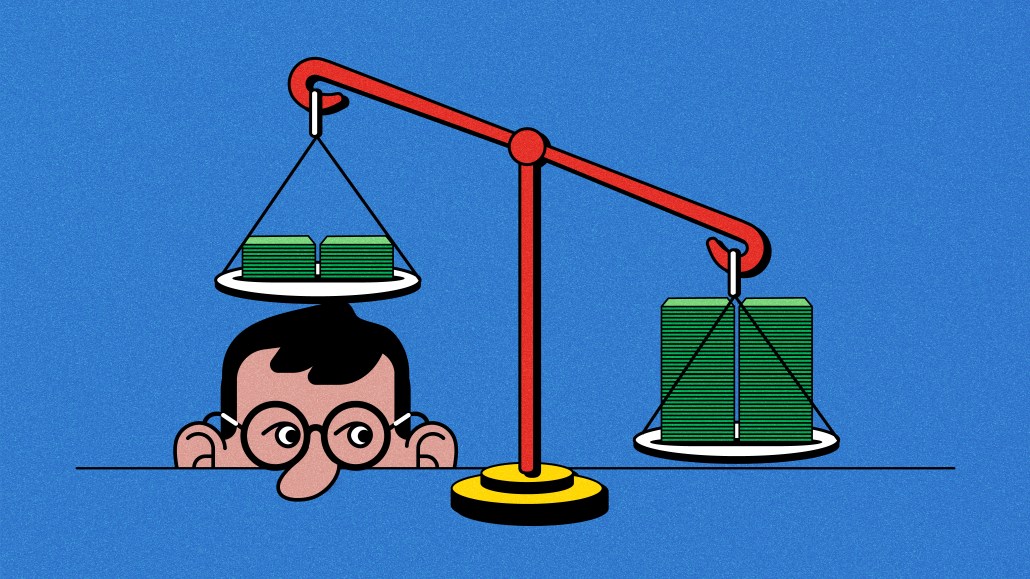Media Buying Briefing: The upfront isn’t moving along for a few surprising reasons

This Media Buying Briefing covers the latest in agency news and media buying for Digiday+ members and is distributed over email every Monday at 10 a.m. ET. More from the series →
For most of the last 50 years since the upfront was an integral part of marketers’ plans to advertise on TV, the buying bonanza usually wrapped up business between TV sellers and buyers before the July Fourth break. That is definitely not the case this year, for a few reasons.
According to three heads of investment at major agency groups, the multi-billion dollar marketplace is being slowed down for three reasons: its increasing complexity, discrepancies with Nielsen’s latest ratings system, and lingering confusion over which agency is responsible for upfront negotiations with clients that have recently moved their business from one holdco to another.
The first reason has been the case for at least a few years now, since the pandemic irrevocably changed TV viewing habits, bringing on the general decline in linear viewership and accelerating the rise of streaming and connected TV viewing options.
“There’s so many different dynamics now, it’s difficult to say that there is kind of one trend that’s driving everything,” said one multi-agency head of investment who spoke on condition of anonymity in order to speak freely.
The buyer cited myriad factors that need to get sorted with streaming and platform deals, from pricing to cancellation options to dollar volume, which all the major streamers are looking to increase. “There’s certain elements of this that are dragging out out because you have very limited supply — and you have an abundance of supply where demand hasn’t caught up in others,” said the buyer.
The situation with Nielsen revolves around Nielsen’s introduction of its Big Data + Panel (BD+P) ratings, which increased the sample size of its audience from a panel of 42,000 homes to 45 million smart TV homes — a significant shift in sample size, to understate the matter. At the beginning of 2025, Nielsen received accreditation from the Media Rating Council — a big step in validation after losing accreditation in 2021.
Certainly some variance in the numbers was expected, and it seemed possible this new system would add wrinkles to the upfront. But the head of investment at a second agency group said the problem is the inconsistency in the numbers — the fluctuation keeps going up and down without making sense.
“It’s an absolute freaking mess, and it is holding up conversations with a lot of different holding companies,” said the buyer. “With Nielsen being Nielsen, the numbers are wonky. By their own admission, Nielsen said that the adults 25-54 numbers are wrong, and most of my deals are done on adults 25-54.”
The buyer pointed out that over the last year, ratings for a major Hispanic network went from 35% higher in BD+P compared to panel-only to 2% lower in the most recent numbers — wildly divergent. While the numbers for a smaller cable network group dropped 23% from panel to BD+P.
With the latter example, “If we did this the correct way, their CPM would go up by 23% then they’re now going to be priced higher than [the parent channel]. So we’re not going to buy any of that network. We’re going to pull the dollars from there, and they’re likely going to go out of business,” said the buyer.
For its part, Nielsen knows its new ratings aren’t perfect, but argued that the problems are sporadic at best. “The vast majority of clients on both the buy and sell sides support and encourage Big Data + Panel as currency,” wrote a Nielsen representative in an email reply. “We’re thrilled that Big Data + Panel is being embraced. We’ve worked hand in hand with clients for years to get to this point and we’re proud to be the first company to earn accreditation for this new frontier in measurement. We remain committed to our clients so that we can help them achieve their goals.”
Meanwhile, the second buyer said they’re hearing from Nielsen’s competitors including Videoamp and Comscore, but that buyer added that the alternatives all have holes in their offerings too, so that buyer will continue to work through BD+P and said it’s just going to take longer to get to the bottom of where the ratings settle.
Finally, the moves by a handful of major clients to shift North American media budgets from one holding company to another — thinking specifically about Coca-Cola’s and Mars’ moves from WPP Media to Publicis as the two biggest of the last six months — have caused a bit of confusion over which agency is actually handling upfront negotiations. But there are others, from Marco’s pizza to P&G’s Oral Care to PayPal — all of which add up to some $1 billion in spend that’s currently in flux from one agency group to another.
“If I’m actually going to have to go back and negotiate the inclusion of those clients into deals that I’ve already struck, that’s going to be a difficult part of the process,” said a buyer.
Publicis Media declined to comment on which group is handling which part of the upfront negotiations, and WPP Media didn’t respond to a request for comment by press time.
So when will the market wrap? One buyer said they plan to get to finalizing business starting today July 7, and could be finished by end of the week.
The first buyer added that it’s going to take whatever time is needed to get the best deal for clients: “If a negotiation is dragging on, it’s it’s because it needs to, to make sure that we’re delivering adequate value across the board.”
Color by numbers
No one can deny gaming has had a profound impact on the time spent on different entertainment sources, especially for younger people. Less clear is the impact it’s had on people’s brand choices — since advertising through gaming has had its ups and downs over the last decade. Dentsu recently issued a report on the state of gaming, and here are some stats on what it found:
- There are over 3.4 billion gamers worldwide (41% of the global population), with time spent in games is up 6% year over year
- Still, gaming only captures less than 5% of global media investment
- 43% of gamers say a gaming partnership improves their perception of a brand
- 44% of Twitch viewers have purchased a product recommended by a streamer
- Gen Z and Millennials are 64% more likely than older generations to discover new brands through mobile game ads.
Takeoff & landing
- Havas’ Forward Media unit won most of LVMH’s media business in Europe from Publicis, effective January 2026, according to several reports. Forward already handles media for the luxury brand holdco in Italy and Latin America.
- Stagwell’s Assembly is launching new unit called Assembly Control, which aims to bring brand safety, suitability, and performance optimization to its new programmatic suite.
- IPG’s global CEO of UM, Andrea Suarez, is reported to have left the holding company amid a restructure that will see most of the holding company’s global CEOs be replaced by brand presidents.
- Horizon Media expanded its product and data leadership teams with three external hires: Krish Kuruppath was named evp, head of tech; Jeremy Flynn was named evp, head of product; and Allan Johnston was named svp, head of program management.
Direct quote
“There’s a real reckoning coming as consumer habits shift in an accelerated fashion and publishers bury their heads in the sand.”
— Matt Barash, chief commercial officer at Nova, responding to an Atlantic article “The End of Publishing As We Know It,” which was posted on LinkedIn by ex-Netflix exec Peter Naylor.
Speed reading
- Sam Bradley looked into the specialty units agencies like Jellyfish, WPromote and Kepler are creating to handle the changes AI is having on how consumers search these days.
- In his latest Future of TV Briefing, Tim Peterson addressed how YouTube’s dominance in TV viewing differs among age groups on whether it’s dominant on TV screens or smartphones.
- Kimeko McCoy tapped into the knowledge and experience of Uber Ads’ Kristi Argyilan to understand how retail media networks are adapting to becoming full-funnel options rather than performance marketing machines.
More in Media Buying

Ad Tech Briefing: Big Tech won 2025 (even when it lost)
How AI, commerce media and scale reshaped ad tech in 2025 to the benefit of Big Tech.

How brands shifted marketing and media strategies through year of tariffs
Marketers share how they navigated the maze of tariffs and regulatory changes this year.

Media Buying Briefing: Omnicom Media execs begin their pitch outreach ahead of an expected new-business glut
Omnicom’s acquisition of IPG is only a few weeks old, but its combined offer to the market will soon be put to the test as it meets with consultants.








